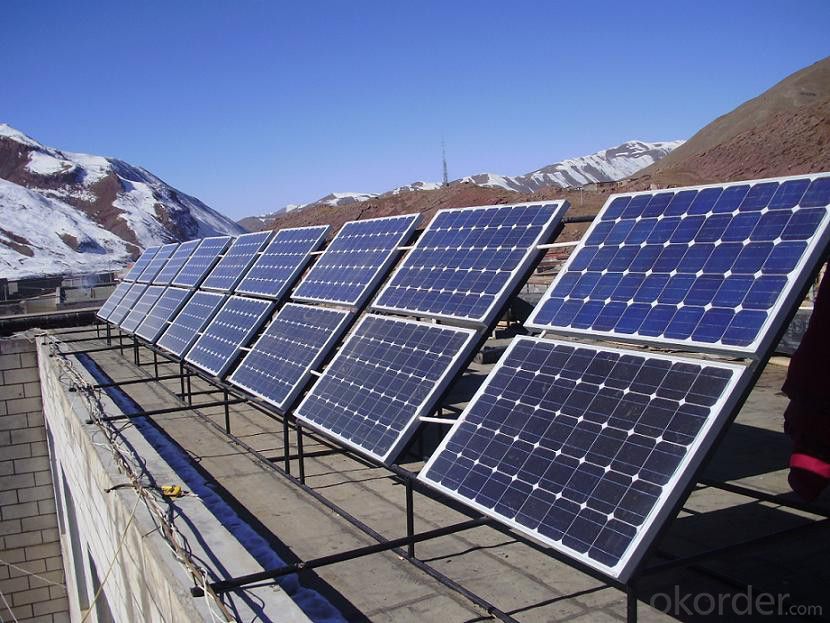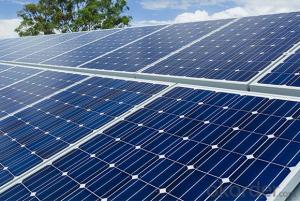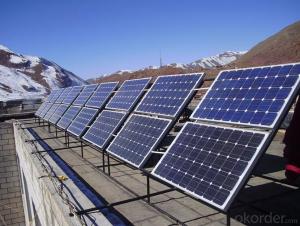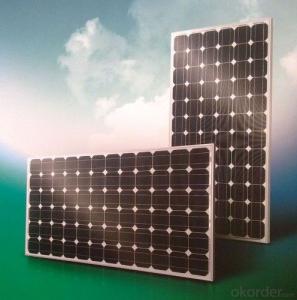CNBM Solar Monocrystalline 6 Series (70-80W)
- Loading Port:
- China main port
- Payment Terms:
- TT OR LC
- Min Order Qty:
- 100000 watt
- Supply Capability:
- 10000000 watt/month
OKorder Service Pledge
OKorder Financial Service
You Might Also Like
Mono-crystalline Solar Module Description:
Mono-crystalline solar module is the core part of solar power systems, as well as the most important part of the solar system. Mono-crystalline solar module consists of high efficiency crystalline silicon solar cell, super white cloth grain toughened glass, EVA, transparent TPT backboard and the composition of aluminum alloy frame. The function of Mono-crystalline solar module is to convert solar energy into electric energy, or sent to the storage battery, or promote work load. The quality of the solar energy battery components and cost will directly decide the quality and cost of the whole system.

Data sheet
| Characteristics | |
| Max Power Voltage Vmp (V) | 17.2V-17.4V-17.6V |
| Max Power Current Imp (A) | 4.07A-4.32A-4.55A |
| Open Circuit Voltage Voc (V) | 22.2V-22.4V-22.6V |
| Short Circuit Current Isc (A) | 4.35A-4.61A-4.87A |
| Max Power Pm (W) | 70W-75W-80W |
| Temperature Coefficient of Cells | |
| NOCT | 47℃±2℃ |
| Temperature Coefficients of Isc (%/℃) | 0.06% |
| Temperature Coefficients of Voc (%/℃) | -0.32% |
| Temperature Coefficients of Pmp (%/℃) | -0.45% |
| Mechanical Data | |
| Type of Cells (mm) | Mono156*78 Mono156*39 |
| Dimension | 780×670×30mm |
| Weight | 5.9kg |
| NO.of Cells and Connections | 4×9=36/4*18=72 |
| Limits | |
| Operating Temperature | –45°C to +80°C |
| Storage Temperature | –45°C to +80°C |
| Max System Voltage | 700V |
FAQ:
1. How long will my inquiry get response?
Your inquiry related to our products or prices will be replied within 24 hours.
2. Can I get professional service and suggestion?
Well-trained and experienced staffs to answer all your questions in fluent English.
3. Do you accept OEM or customized design?
OEM & ODM, any your customized lightings we can help you to design and put into product.
4. What if I need specific design?
Distributorship are offered for your unique design and some our current models.
- Q:Still researching for a car that fully uses solar power energy, suggestions would be nice to.
- Build okorder /
- Q:i need someone to advice me which solar panels to buy.i have looked into few companies and i need some more info before decidingthe companies i checked were Sun tech trina solar Canadian solar and LDK solar.whice company should i pick?? please help.
- Selecting the right solar panels is like shopping for a car. Shop around and compare prices. Make sure the frame material will not rust or corrode away after a few years if you are near the ocean. Talk to satisfied customers is always wise. Get the guarantee in writing.
- Q:Can solar panels be installed on a library or educational institution?
- Yes, solar panels can be installed on a library or educational institution. In fact, installing solar panels on such buildings is a great way to promote renewable energy and reduce carbon emissions. It not only helps to lower electricity bills but also serves as an educational tool, teaching students and visitors about the benefits of solar power and sustainable living.
- Q:Do solar panels require permits for installation?
- Yes, in most cases, solar panels require permits for installation. The specific requirements and regulations vary depending on the location, but obtaining permits ensures that the installation meets safety standards and compliance regulations set by local authorities.
- Q:Can solar panels be installed on community buildings?
- Yes, solar panels can be installed on community buildings. In fact, community buildings like schools, libraries, and community centers are excellent candidates for solar panel installations as they often have large roofs or open spaces that can accommodate solar arrays. Installing solar panels on community buildings not only helps reduce electricity costs but also promotes sustainability and clean energy in the community.
- Q:Why might energy from the solar panels sometimes be near zero even in the summer?
- Hey Cosmic, forget about Wayfare and Jenny here, but I have to say your question is a bit vague. When you say the panels produce near zero, how near? Are you using a watt meter, ammeter, or some other sort of metering device. Solar electric, or photovoltiac panels are made almost entirely of silicone wafers. Same as computer chips, when they get hot, the resist the flow of electrons. This is why most panel manufacturers advise installers to upgauge wiring if the temperature falls below 40 degrees F (5C) regularly. Below 0 C, you have to upgauge 2 wire sizes. A good quality panel will put out 50% of its rated power in very cold climates, so it stands to reason that they will put out substantially less in hot weather. Many people think places like the SW United States is great for solar because it's always sunny. In Las Vegas for example, they have 27 sunny days a month, and in August, the temperature frequently reaches 50 degrees C (20F) so people with photovoltiac panels are not even getting half their rated power on a good day. I'm not sure this is what you are asking about. Our home has been powered by the wind and sun for 2 years now. In the summer in the upper midwest, the days are warmer of course, but also much longer than in the winter. So our batteries will frequently fill up by 2:00pm, and the charge controller will taper off the solar charging the rest of the day to minimize overcharging. If you were to check the meters at 3pm, you might notice only 3 or 4 amps coming in when the array is rated at 42. This is normal for us in July and August. These are some reason why a solar array produces near zero in the summertime. Take care Cosmic, Rudydoo
- Q:Can solar panels be used in hot climates?
- Yes, solar panels can be used in hot climates. In fact, solar panels actually perform better in higher temperatures as they rely on sunlight rather than heat to generate electricity. However, excessive heat may slightly reduce the efficiency of the panels, but modern solar technology is designed to handle and adapt to varying weather conditions, including hot climates.
- Q:the solar panel works with LEDs, small bulbs,etc but neve with any dcmotor. Please help. I have a science exhibition.
- It may be that the power output of your solar panel is not enough to drive the DC motor. It is producing up to 6 volts but it may not be producing many milliamps. LEDs need very little power to work but DC motors often need quite a high current to get them turning. If you can run several solar panels in parallel, you can probably increase the available current. Alternatively, can you expose the existing panel to much more light so as to get it to work at its maximum output? That might work. Good luck with your science exhibition.
- Q:What is the most affordable, yet highest watt solar panels available?
- in case you raise a dumb-bell a undeniable style of feet, you have expended a undeniable volume of potential, does this variation if the gymnasium exchange into on yet another floor of the construction? Grounding is needed for defense and to dodge floor loops from happening, the quantity of potential produced would not exchange and any adjustments in potential will bring about a risky floor loop attempting to equalize it.
- Q:Can solar panels be installed on remote monitoring systems?
- Yes, solar panels can be installed on remote monitoring systems. Solar panels provide a reliable and sustainable source of energy for remote monitoring systems, allowing them to operate autonomously and continuously in remote locations without the need for grid power or frequent battery replacements.
1. Manufacturer Overview |
|
|---|---|
| Location | |
| Year Established | |
| Annual Output Value | |
| Main Markets | |
| Company Certifications | |
2. Manufacturer Certificates |
|
|---|---|
| a) Certification Name | |
| Range | |
| Reference | |
| Validity Period | |
3. Manufacturer Capability |
|
|---|---|
| a)Trade Capacity | |
| Nearest Port | |
| Export Percentage | |
| No.of Employees in Trade Department | |
| Language Spoken: | |
| b)Factory Information | |
| Factory Size: | |
| No. of Production Lines | |
| Contract Manufacturing | |
| Product Price Range | |
Send your message to us
CNBM Solar Monocrystalline 6 Series (70-80W)
- Loading Port:
- China main port
- Payment Terms:
- TT OR LC
- Min Order Qty:
- 100000 watt
- Supply Capability:
- 10000000 watt/month
OKorder Service Pledge
OKorder Financial Service
Similar products
New products
Hot products
Related keywords





























